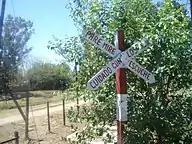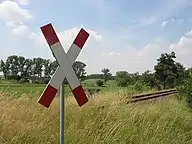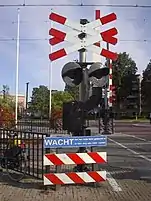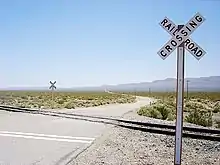
A crossbuck is a traffic sign used to indicate a level railway crossing. It is composed of two slats of wood or metal of equal length, fastened together on a pole in a saltire formation (resembling the letter X). Crossbucks are sometimes supplemented by electrical warnings of flashing lights, a bell, or a boom barrier that descends to block the road and prevent traffic from crossing the tracks.
Vienna Convention
The Vienna Convention on Road Signs and Signals, a multilateral treaty of the United Nations with the intention of standardizing traffic signs around the world, prescribes several different regulations for the "crossbuck" sign.
The sign should consist of two arms not less than 1.2 metres (3.9 ft) long, crossed in the form of an ![]() . The first model may have a white or yellow ground with a thick red or black border. The second model may have a white or yellow ground with a thin black border and an inscription, such as "RAILWAY CROSSING". If lateral clearance obstructs the placement of the sign, it may be rotated 90° so that its points are directed vertically. If used at a level crossing with more than 1 set of tracks, a half cross or a supplementary plate stating the number of tracks may be added below.
. The first model may have a white or yellow ground with a thick red or black border. The second model may have a white or yellow ground with a thin black border and an inscription, such as "RAILWAY CROSSING". If lateral clearance obstructs the placement of the sign, it may be rotated 90° so that its points are directed vertically. If used at a level crossing with more than 1 set of tracks, a half cross or a supplementary plate stating the number of tracks may be added below.
Most countries use one of these models:
 Worldwide
Worldwide Finland, Greece, Nigeria
Finland, Greece, Nigeria

 Cambodia, France, Francophone Africa, Haiti
Cambodia, France, Francophone Africa, Haiti
 Australia, New Zealand, the Philippines
Australia, New Zealand, the Philippines
Variants around the world
In the United States, the crossbuck carries the words "RAIL" and "ROAD" on one arm and "CROSSING" on the other ("RAIL" and "ROAD" are separated by the "CROSSING" arm), in black text on a white background. Older variants simply used black and white paint; newer installations use a reflective white material with non-reflective lettering. Some antique U.S. crossbucks were painted in other color schemes, and used glass "cat's eye" reflectors on the letters to make them stand out. Other countries, such as China, also use this layout, but with appropriately localized terms. Often, a supplemental sign below the crossbuck indicates the number of tracks at the crossing.
A special kind of crossing sign assembly was introduced on an experimental basis in Ohio in 1992, the "Buckeye Crossbuck". It included an enhanced crossbuck, reflective and with red lettering, and also a reflective plate reading "YIELD" below the crossbuck, whose sides are bent backwards in order to catch and reflect at a right angle the light of an approaching train. The experiment's final report gave the device a favorable review;[1] however, the plate, R15-9 "Crossbuck Shield", was rejected for inclusion in the 2003 Manual on Uniform Traffic Control Devices.[2]
In Canada, crossbucks have a red border and no lettering. These were installed in the 1980s shortly after English-French bilingualism was made official, replacing signs of a style similar to those used in the U.S., except the word "RAILWAY" was used instead of "RAILROAD" and in certain areas the words "TRAVERSE DE CHEMIN DE FER" were used.
In Mexico, the crossbucks read "CRUCERO FERROCARRIL", a literal translation of its U.S. counterpart. Older designs read "CUIDADO CON EL TREN", meaning "beware of the train".
In Argentina, the most common legend is "PELIGRO FERROCARRIL" ("danger: railroad"). Other crosses also read "CUIDADO CON LOS TRENES - PARE MIRE ESCUCHE ("beware of the trains - stop, look, listen") for the Ferrocarril Belgrano, "PASO A NIVEL - FERRO CARRIL" for the Ferrocarril Mitre and "CUIDADO CON LOS TRENES" ("beware of the trains") for the Ferrocarril Roca.
In parts of Europe, the cross is white with red trimmings or ends, sometimes on a rectangular background; in Finland and Greece the cross is yellow, trimmed with red.
Taiwan uses two crossbucks: a version with a yellow and black cross, and one with the cross in white with a red border. A special symbol in the center indicates an electric railroad crossing, cautioning road users about excessive height cargo that may contact the electric wires.
In Australia, the crossbuck is a St Andrews Cross as in Europe, but uses words and the same color as the American crossbuck. In contrast to the American "RAILROAD CROSSING", Australian signs say "RAILWAY CROSSING" or "TRAMWAY CROSSING". (Most cases where a tram in its own right-of-way crosses a road do not use a crossbuck and so are regular intersections rather than level crossings.)
Different countries may classify the sign differently. For example, in Australia it is considered a regulatory sign, while in close neighbour New Zealand it is considered a warning sign. Some countries, such as Australia, France, New Zealand, Slovakia and Slovenia may place the crossbuck design on a "target board", while other countries quite often do not. In the United Kingdom, it is only used for crossings with no barriers or signal lights.
Crossbucks of the world
 Australia (variant)
Australia (variant) Austria
Austria Austria (vertical)
Austria (vertical) Austria (variant)
Austria (variant) Belgium
Belgium Bosnia and Herzegovina, Croatia, Germany, Malaysia, North Macedonia, Slovakia
Bosnia and Herzegovina, Croatia, Germany, Malaysia, North Macedonia, Slovakia.svg.png.webp) Botswana, Zambia, Zimbabwe (former)
Botswana, Zambia, Zimbabwe (former) Brazil
Brazil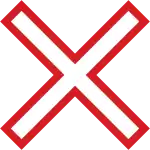 Canada
Canada.png.webp) Canada (former)
Canada (former)_(old).svg.png.webp) Canada (former)
Canada (former)_(old).svg.png.webp) Canada (formerly used in Quebec)
Canada (formerly used in Quebec) Central America
Central America Chile and Colombia
Chile and Colombia.svg.png.webp) Colombia (former)
Colombia (former) Denmark
Denmark Georgia
Georgia Italy
Italy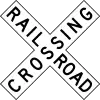 Jamaica and United States
Jamaica and United States.svg.png.webp) Japan, Taiwan (and remnant at one signal in the Philippines at Paco Station, Manila)
Japan, Taiwan (and remnant at one signal in the Philippines at Paco Station, Manila)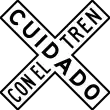 Mexico
Mexico Netherlands
Netherlands New Zealand (variant)
New Zealand (variant) Norway
Norway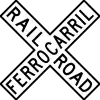 Panama
Panama Peru
Peru Poland
Poland Romania
Romania Romania (variant used for railway crossings without gates and lights)
Romania (variant used for railway crossings without gates and lights) South Korea
South Korea Sweden
Sweden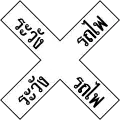 Thailand
Thailand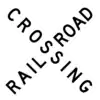 United States (inverted variant)
United States (inverted variant)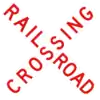 United States (experimental version used in Ohio for a time)
United States (experimental version used in Ohio for a time)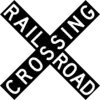 United States (variant, former)
United States (variant, former) Venezuela
Venezuela
Multiple tracks
Several countries use a sign to indicate that multiple tracks must be crossed at a level crossing. In Australia, Canada, New Zealand, and the U.S., a sign is mounted beneath the crossbuck (above the warning light assembly, if any) with the number of tracks. Many European countries use multiple crossbucks or additional chevrons ("half-crossbucks") below the first one. Taiwan also uses half-crossbucks below the regular crossbuck.
 Vienna Convention sign with "half cross" (Worldwide)
Vienna Convention sign with "half cross" (Worldwide) Vienna Convention sign with "half cross" (Finland, Greece, Nigeria)
Vienna Convention sign with "half cross" (Finland, Greece, Nigeria) Vienna Convention sign with "half cross" (Cambodia, France, Francophone Africa)
Vienna Convention sign with "half cross" (Cambodia, France, Francophone Africa) Vienna Convention sign with supplementary plate (Australia and New Zealand)
Vienna Convention sign with supplementary plate (Australia and New Zealand).svg.png.webp) Australia (variant)
Australia (variant)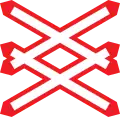 Austria
Austria Austria (vertical)
Austria (vertical) Austria (variant)
Austria (variant) Belgium
Belgium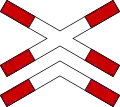 Bosnia and Herzegovina, Croatia, North Macedonia
Bosnia and Herzegovina, Croatia, North Macedonia Brazil
Brazil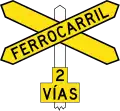 Chile
Chile.svg.png.webp) Colombia
Colombia Denmark
Denmark Georgia
Georgia Italy
Italy Netherlands
Netherlands.svg.png.webp) New Zealand (variant)
New Zealand (variant)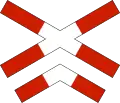 Norway
Norway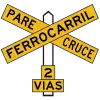 Peru
Peru Poland
Poland Romania
Romania Romania (variant used for railway crossings without gates and lights)
Romania (variant used for railway crossings without gates and lights)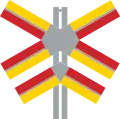 Sweden
Sweden United States
United States Venezuela
Venezuela
Advance warning
Several countries include the crossbuck iconography in their warning signs for a railway crossing ahead.
 Vienna Convention sign (triangle, used in the Philippines for railway crossings without gates and lights)
Vienna Convention sign (triangle, used in the Philippines for railway crossings without gates and lights)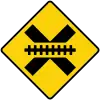 Vienna Convention sign (diamond, used in most Latin American countries except Argentina and formerly used in Ireland for railway crossings without gates and lights)
Vienna Convention sign (diamond, used in most Latin American countries except Argentina and formerly used in Ireland for railway crossings without gates and lights) Australia and New Zealand
Australia and New Zealand.svg.png.webp) Australia (former) and Jamaica
Australia (former) and Jamaica.svg.png.webp) Australia (side road)
Australia (side road) Australia (variant with warning lights)
Australia (variant with warning lights).svg.png.webp) Canada (former)
Canada (former) Canada (current)
Canada (current)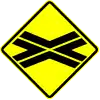 Panama (variant for railroad crossings without gates but with lights)
Panama (variant for railroad crossings without gates but with lights) Philippines
Philippines United States
United States United States (dormant railroad crossing)
United States (dormant railroad crossing)
See also
References
- ↑ Russ College of Engineering and Technology (December 2000). "Evaluation of the Buckeye Crossbuck at Public, Passive Railroad/Highway Grade Crossings in Ohio" (PDF). Ohio Department of Transportation. Retrieved 2009-11-04.
- ↑ 68 FR 65572 (2003-11-20) "Given the strong response opposing the proposal, the FHWA believes that the proposal of the Crossbuck Shield was premature and removes all text and graphic references regarding the Crossbuck Shield sign from this final rule."
External links
- Part 8. Traffic Control for Railroad and Light Rail Transit Grade Crossings, U.S. Manual on Uniform Traffic Control Devices, 2009 ed.
